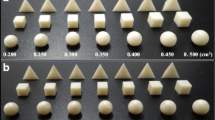Summary
The ability of human subjects to discriminate plane metal plates of different thickness was measured using a forced-choice paradigm. The plates, made by electroplating a thin layer of copper onto flat brass shims, were gripped between the thumb and the index finger. Subjects were presented with either 2 standard plates (0.2 mm thick), or a standard plate and a test plate that was slightly thicker, and were required to state which alternative had occurred. When the edges of the plates could not be touched, a difference in thickness of about 0.075 mm could be discriminated. Surprisingly, when the edges were included in the grip, performance did not improve. All hypotheses of strategies used by the subjects required them to sense the angles of the finger joints with a precision of about 0.1°.
Similar content being viewed by others
References
Aniss AM, Gandevia SC, Milne RJ (1988) Changes in perceived heaviness and motor commands produced by cutaneous reflexes in man. J Physiol (Lond) 397:113–126
Backhouse KM, Catton WT (1954) An experimental study of the functions of the lumbrical muscles in the human hand. J Anat 88:133–141
Bair RR, Swalheim DA (1953) High efficiency cyanide copper. In: Gray AG (ed) Modern electroplating. John Wiley, New York, pp 213–225
Browne K, Lee J, Ring PA (1954) The sensation of passive movement at the metatarsophalangeal joint of the great toe in man. J Physiol (Lond) 126:448–458
Burgess PR, Mei J, Tuckett RP, Horch KW, Ballinger CM, Poulos DA (1983) The neural signal for skin indentation depth. I. Changing indentations. J Neurosci 3:1572–1585
Burke D, Gandevia SC, Macefield G (1988) Responses to passive movement of receptors in joint, skin and muscle of the human hand. J Physiol (Lond) 402:347–361
Devanandan MS, Ghosh S, John KT (1983) A quantitative study of muscle spindles and tendon organs in some intrinsic muscles of the hand in the bonnet monkey (Macaca radiata). Anat Rec 207:263–266
Dietze AG (1961) Kinaesthetic discrimination: the difference limen for finger span. J Psychol 51:165–168
Evans GB, Howarth E (1966) The effect of grip-tension on tactile-kinaesthetic judgement of width. Quart J Exp Psychol 18:275–277
Ferrel WR, Gandevia SC, McCloskey DI (1987) The role of joint receptors in human kinaesthesia when intramuscular receptors cannot contribute. J Physiol (Lond) 386:63–71
Ferrel WR, Smith A (1988) Position sense at the proximal interphalangeal joint of the human index finger. J Physiol (Lond) 399:49–61
Gandevia SC, McCloskey DI (1976) Joint sense, muscle sense, and their combination as position sense, measured at the distal interphalangeal joint of the middle finger. J Physiol (Lond) 260:387–407
Gaydos HF (1958) Sensitivity in the judgment of size by fingerspan. Am J Psychol 71:557–562
Hulliger M, Nordh E, Thelin A-E, Vallbo AB (1979) The responses of afferent fibres from the glabrous skin of the hand during voluntary finger movements in man. J Physiol (Lond) 291:233–249
Johansson RS, LaMotte RH (1983) Tactile detection thresholds for a single asperity on an otherwise smooth surface. Somatosens Res 1:21–31
John KT, Devanandan MS (1988) Sensory innervation and motor properties of the lumbrical muscles in the primate hand. Neurosci Lett 30:S81
Johnson KO (1980) Sensory discrimination: decision process. J Neurophysiol 43:1771–1792
Landsmeer JMF (1976) Atlas of anatomy of the hand. Churchill Livingstone, Edinburgh London New York
Long C, Brown ME (1964) Electromyographic kinesiology of the hand: muscles moving the long finger. J Bone Jt Surg 46A: 1683–1706
McCloskey DI (1978) Kinesthetic sensibility. Physiol Rev 58:763–820
McFadden D (1970) Three computational versions of proportion correct for use in forced-choice experiments. Percept Psychophys 8:336–342
Noth J, Matthews HR, Friedemann H-H (1984) Long latency reflex force of human finger muscles in response to imposed sinusoidal movements. Exp Brain Res 55:317–324
Phillips JR, Johnson KO (1981) Tactile spatial resolution. II. Neural representation of bars, edges, and gratings in monkey primary afferents. J Neurophysiol 46:1192–1203
Provins KA (1958) The effect of peripheral nerve block on the appreciation and execution of finger movements. J Physio1 (Lond) 143:55–67
Stevens SS, Stone G (1959) Finger span: ratio scale, category scale, and jnd scale. J Exp Psychol 57:91–95
Vallbo AB (1970) Discharge patterns in human muscle spindle afferents during isometric voluntary contractions. Acta Physiol Scand 80:552–566
Vallbo AB, Johansson RS (1984) Properties of cutaneous mechanoreceptors in the human hand related to touch sensation. Human Neurobiol 3:3–14
Author information
Authors and Affiliations
Rights and permissions
About this article
Cite this article
John, K.T., Goodwin, A.W. & Darian-Smith, I. Tactile discrimination of thickness. Exp Brain Res 78, 62–68 (1989). https://doi.org/10.1007/BF00230687
Received:
Accepted:
Issue Date:
DOI: https://doi.org/10.1007/BF00230687




